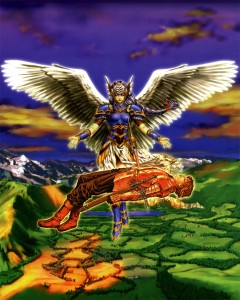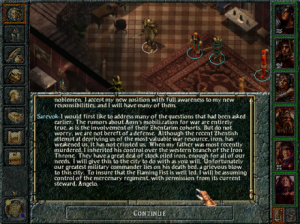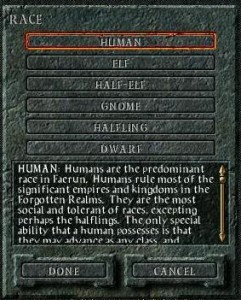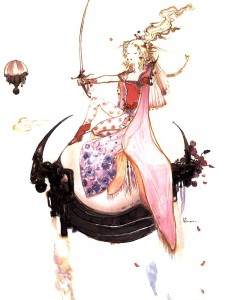The culprit: Final Fantasy VII (PlayStation, PlayStation Network, PC)
Reviewing Final Fantasy VII is somewhat daunting, because of the enormous hype that surrounds this monolith of videogaming culture. The first Final Fantasy game to hit the PS, introducing cinematics and 3D, it’s unquestionably the most popular episode in the series and has achieved cult status, since it was many people’s first FF. If you want an indication of the scope of the phenomenon, try browsing an RPG-related forum, and you’re likely to encounter several screenname variations on either Cloud or Sephiroth. The other measure of the game’s popularity is the number of spinoffs it has generated: an OVA (Last Order), an animated film sequel (Advent Children), two prequels (Crisis Core and Before Crisis) and a spinoff sequel featuring what was originally an optional character (Dirge of Cerberus). I’m not even sure that the naming of these spinoffs was accidental (AC, BC, CC and DC? Come on…).
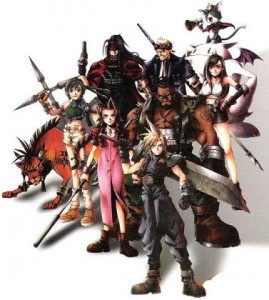 I won’t deny that the game has its merits: the characters are memorable (whether in a good or bad way), the villain has style and flair, the story is compelling and has little in common with preceding games in the series. Where FFVI only dabbled in steampunk, this one dabbles, dips and takes a belly-flop into it, transporting the series into a completely futuristic setting, with the heroes facing a radically different set of problems than in the previous opuses. There are still super-deformed sprites–which, incidentally, look like Legos, with their blocky hands and lack of noses–, but the characters also get the luxury of normally-sized incarnations during cinematic sequences and battles, thus taking expressiveness to a new level. Summoning sequences are also one of the big graphical highlights. Granted, by modern-day standards, the quality is very dated, but you can imagine just how awesome it must have seemed back when the game first came out.
I won’t deny that the game has its merits: the characters are memorable (whether in a good or bad way), the villain has style and flair, the story is compelling and has little in common with preceding games in the series. Where FFVI only dabbled in steampunk, this one dabbles, dips and takes a belly-flop into it, transporting the series into a completely futuristic setting, with the heroes facing a radically different set of problems than in the previous opuses. There are still super-deformed sprites–which, incidentally, look like Legos, with their blocky hands and lack of noses–, but the characters also get the luxury of normally-sized incarnations during cinematic sequences and battles, thus taking expressiveness to a new level. Summoning sequences are also one of the big graphical highlights. Granted, by modern-day standards, the quality is very dated, but you can imagine just how awesome it must have seemed back when the game first came out.
That being said, I’m one of those people that have always felt that FFVII was absurdly overrated. Yes, it’s a very good game; yes, I would gladly replay it anytime, but it’s been blown out of all proportion. Some fans would have you believe that it’s the ultimate masterpiece of videogaming: well…it isn’t. I don’t even number it among my top five games in the series. And even objectively speaking, there have since been better, more innovative and interesting games in general, whether in terms of storyline, characterisation or atmosphere (I won’t say graphics, because that’s not a fair criterion). First of all, the ending is seriously underwhelming. This may be one of the driving reasons behind the spinoffs (besides the desire to milk fans for cash capitalise on the game’s popularity), but you may be left wondering “was that really it?” Secondly, a sizeable chunk of the cast consists of characters I strongly dislike, which makes it a little difficult for me to empathise with them. Thirdly, the driving idea behind the storyline may be a good one, but the execution is somewhat…lacking in places, and the tone of the game is sometimes almost jarringly goofy. Mind you, I’m judging this by juxtaposition with the hype FFVII has generated: had we simply been talking about a ‘normal’ game, I wouldn’t be that bothered by it. And last, but not least, the translation is not up to scratch in some places. There are mistakes, inconsistencies, and let me insist how lucky you are if you’ve only played this in English. My first copy of the game was in French, and boy, was that ten times worse.
FFVII has never been remade, much to the dismay of fanboys and fangirls the world over. However, if you own a PS or a PC, the original game is freely accessible–although PS copies are probably rather expensive now–, and there are plenty of good reasons why you should give it a go if you haven’t already, even if it’s just to see what all the fuss is about. Just don’t expect a life-altering experience, that’s all I’m saying.
Detailed review available! Read more here.

